| Vernon Arena | |
|---|---|
 Ring at Jack Doyle's club, Vernon, California Ring at Jack Doyle's club, Vernon, California(George Rice & Sons printers, Los Angeles, c. 1916, scanned by Catherine Johnson from personal collection) | |
| Alternative names | Vernon Coliseum, Vernon Club, Jeffries' Vernon Arena, Jack Doyle's Training Camp, Doyle's Vernon Arena, Vernon Athletic Club |
| General information | |
| Address | Santa Fe & 26th (McCarey era), S Santa Fe Ave & E 38th St (Doyle era) |
| Town or city | Vernon, California |
| Coordinates | 34°00′29″N 118°13′49″W / 34.0081°N 118.2302°W / 34.0081; -118.2302 (Doyle era) |
The Vernon Arena, located just south of downtown Los Angeles, California, was a major early 20th-century west coast of the United States boxing venue. For much of its history the Vernon Arena was a "pavilion"—an outdoor boxing ring surrounded by seating for spectators—but the Vernon Coliseum, which stood from 1924 to 1927, was an indoor arena with capacity to host about 8,000 people.
History
Vernon Arena is largely significant because of the work of two fight promoters: "Uncle Tom" McCarey and Jack Doyle.
Jefferies, Long & McCarey era
The original Vernon boxing "pavilion" was constructed by boxer Jim Jeffries and ubiquitous West Coast hotel-restaurant-club impresario Baron Long around 1908. Jeffries himself refereed some of the first fights at the venue, although Vernon fights were not financially successful under Jefferies.
The first Vernon boxing arena was being leased by McCarey from owner Jeffries when it caught fire and burned on September 16, 1911. A newspaper profile of McCarey published 1913 reported that he had "controlled the boxing situation" in the city for a dozen years past. According to a history of California boxing, "The Jeffries Club staged a number of notable fights but finally succumbed to the stiffer competition of McCarey's downtown club and went out of business, the plant being taken over by McCarey and operated rather spasmodically for championship bouts for a while until he gave up the Naud Junction location entirely and confined his efforts to putting on 15, 20, and 25 round contests in the Vernon arena." McCarey's Vernon arena was located at 26th and Santa Fe. McCarey departed Los Angeles for New Orleans in December 1914, following the passage of 1914 California Proposition 20. The state of California banned prize fighting (temporarily as it turned out) effective January 1, 1915. The Vernon arena built by Long and Jeffries burned in October 1915.
Doyle era



In the late teens, Doyle replaced McCarey as Vernon's boss of boxing. Doyle had long run a famous bar in Vernon (the city was a wet enclave within dry Los Angeles). According to Los Angeles historian Cecilia Rasmussen, Doyle's first venture in Vernon was "a gigantic saloon, where 37 bartenders rang up liquor sales on 37 cash registers at a 100-foot-long bar. Behind it hung a sign—'If Your Children Need Shoes, Don't Buy Any Booze'—and in the ceiling were peepholes from which to keep an eye on the barmen, patrons, and pickpockets."
Doyle's bar closed in 1919 due to the national prohibition on the sale of alcohol, but he had already set up a training camp that was located out back, past the card room. The two-story hotel structure that a contractor reported he had completed at 38th and Santa Fe in June 1916 may have been the facility known as Jack Doyle's Training Camp. A show-business history published 1934 stated, "All the big fighters of the day, as well as preliminary boys, has-beens, and hope-to-bes, trained at Jack Doyle's camp. The crowds that gathered to watch were drawn from what reporters are wont to call 'all walks of life.' There were pickpockets, fences, promoters, and we-boys. Also there were such celebrities as Earl Rogers, famed criminal attorney and father of Adela Rogers St. Johns, Mr. and Mrs. Jack Cudahy, Anita Baldwin, and the entire movie crowd." According to boxer-actor-trainer Dewitt Van Court, "The camp was patronized by the finest boxers in the land and their popularity drew such huge crowds, particularly on Sundays, that Doyle had to erect a regular arena and surround it with stands which would accommodate several hundred people. To pay for the stands, Doyle charged a nominal admission, and the crowds grew so large that he finally enlarged it to seat several thousand and roofed it over."


Doyle's Vernon Arena became the center of boxing in Los Angeles. According to the Los Angeles Times, "With 'Wad' Wadhams as matchmaker, seven four-round bouts were staged at the Doyle Arena every Tuesday night from 1916 to 1923." With prizefighting illegal, the fighters were officially all "amateurs" engaged in "exhibition" matches. The prizes were medals and "maybe a little 'expense' money". In 1921 fight tickets were priced $1 to $3, and there was a section of the arena reserved for ladies. The last fight at Doyle's original outdoor arena was held August 21, 1923.
Doyle's "Coliseum"
Doyle began planning an indoor arena as early as 1920, intending for a building that fronted on 38th Street "near the north entrance of Maier park a frontage of 160 feet and a depth of 138 feet." Doyle's Vernon Coliseum, as he called it, was opened August 28, 1923, with capacity for 8,000 spectators. With the passage of California Proposition 7, prizefighting was made legal again. In the interim between the passage of Prop 7 and January 13, 1925, the date of the first fight under the new law, a planned 10-round bout between Jimmy McLarnin and Fidel LaBarba, Doyle added another 2,000 seats to the coliseum. Promoter Jack Doyle moved his operation to the Olympic Auditorium in autumn 1926. The indoor arena was destroyed in a fire on July 23, 1927. The fire started in a neighboring "sawdust and shavings" mill, and also destroyed the grandstand of the Maier Park stadium where the Vernon Tigers had once played baseball.
Additional images
-
 Panoramic photo of Wolgast–Rivers boxing match, July 4, 1912: "There are thousands in Los Angeles who saw Ad Wolgast fight Joe Rivers in a never-to-be-forgotten battle at Vernon about nine years ago when both men were knocked out in the 13th round and Wolgast staggered to his feet first and was awarded the decision." The words "Vernon Arena" were written on the print but this is actually the Vernon baseball field—Jack Doyle "used the ballpark for the really big fights (Ad Wolgast was very popular) because he could cram more bodies in more seats".
Panoramic photo of Wolgast–Rivers boxing match, July 4, 1912: "There are thousands in Los Angeles who saw Ad Wolgast fight Joe Rivers in a never-to-be-forgotten battle at Vernon about nine years ago when both men were knocked out in the 13th round and Wolgast staggered to his feet first and was awarded the decision." The words "Vernon Arena" were written on the print but this is actually the Vernon baseball field—Jack Doyle "used the ballpark for the really big fights (Ad Wolgast was very popular) because he could cram more bodies in more seats".
-
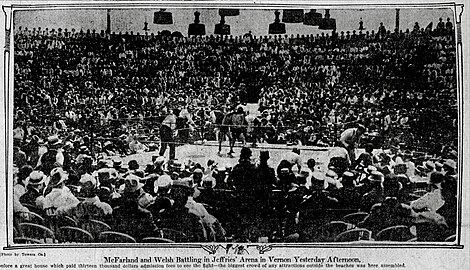 Packy McFarland versus Freddie Welsh, refereed by James J. Jeffries, at Jeffries' Vernon Arena, 1908
Packy McFarland versus Freddie Welsh, refereed by James J. Jeffries, at Jeffries' Vernon Arena, 1908
-
 McCarey (S.F. Bulletin, 1913)
McCarey (S.F. Bulletin, 1913)
-
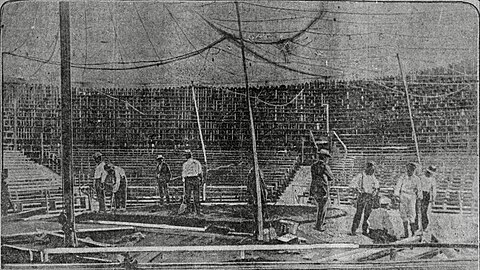 Prepping the Vernon arena for a "Japanese wrestling" exhibition (Los Angeles Times, September 4, 1915)
Prepping the Vernon arena for a "Japanese wrestling" exhibition (Los Angeles Times, September 4, 1915)
-
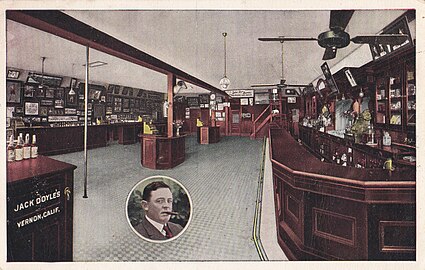 Central Saloon - Jack Doyles Vernon CA (George Rice & Sons printers, Los Angeles, c. 1916)
Central Saloon - Jack Doyles Vernon CA (George Rice & Sons printers, Los Angeles, c. 1916)
-
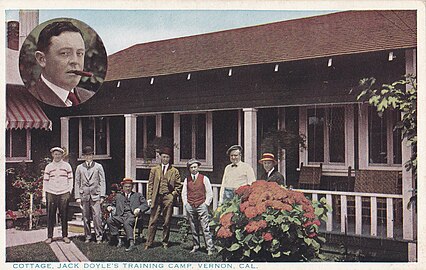 Fighters Cottages - Jack Doyles Vernon CA (c. 1916)
Fighters Cottages - Jack Doyles Vernon CA (c. 1916)
-
 Reception Room - Jack Doyles Vernon CA (c. 1916)
Reception Room - Jack Doyles Vernon CA (c. 1916)
-
 Bud Counihan comic (Los Angeles Times, August 3, 1921)
Bud Counihan comic (Los Angeles Times, August 3, 1921)
-
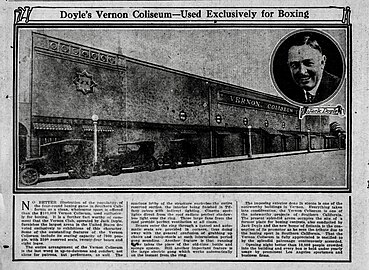 "Doyle's Vernon Coliseum—Used Exclusively for Boxing" (Los Angeles Times, January 1, 1925)
"Doyle's Vernon Coliseum—Used Exclusively for Boxing" (Los Angeles Times, January 1, 1925)
-
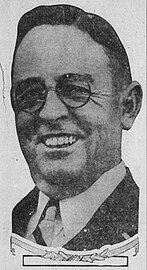 Doyle (L.A. Times, 1926)
Doyle (L.A. Times, 1926)
-
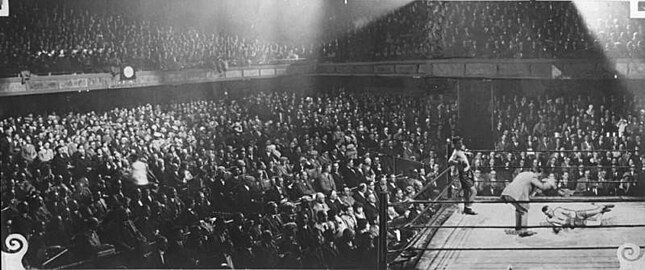 Hayden Phytian defeats Earl Little at Vernon Arena, possibly April 22, 1925
Hayden Phytian defeats Earl Little at Vernon Arena, possibly April 22, 1925
See also
- Hazard's Pavilion
- Hollywood Legion Stadium
- Washington Park (Los Angeles)
- Harry Burns (filmmaker)
- Ship Cafe (Venice, California)
- Los Angeles Union Stock Yards
References
- "Azevedo-Dundee, One Southern Card". Oakland Tribune. September 22, 1913. p. 11. Retrieved 2024-05-16.
- "Fans Have Opportunity to Aid in Securing Heavyweight Battle". Los Angeles Herald. October 27, 1909. p. 12. Retrieved 2024-05-16.
- "Fight Pavilion Burned Down". Evening Vanguard. October 25, 1915. p. 7. Retrieved 2024-05-16.
- "Jeffries Accepts Stage Engagement in This City". The San Francisco Examiner. January 5, 1909. p. 10. Retrieved 2024-05-16.
- "Officers Are Chosen for Jeffries' Club". Oakland Enquirer. March 25, 1908. p. 5. Retrieved 2024-05-16.
- Johnston (1927), p. 254.
- "Thomas J. McCarey". The Los Angeles Times. January 1, 1912. p. 92. Retrieved 2024-05-16.
- "Fire Burns Big Arena". The San Diego Sun. September 16, 1911. p. 9. Retrieved 2024-05-16.
- "'Uncle Tom' M'Carey". The Los Angeles Times. January 1, 1913. p. 90. Retrieved 2024-05-16.
- Van Court & Dobbs (1926), p. 12.
- ^ Henry, Bill (February 10, 1937). "Revival of 10-Round Days Recalled". Hollywood in Sport. The Los Angeles Times. p. 33. Retrieved 2024-08-14.
- "Uncle Tom to Hold Fights in New Orleans". The Los Angeles Times. December 7, 1914. p. 17. Retrieved 2024-05-16.
- Ashbaugh, Don (February 2, 1936). "Sports World Mourns ' Uncle Tom's ' Passing - Father of Local Boxing, He Brought Ring Stars to L.A." The Los Angeles Times. p. 28. Retrieved 2024-05-17.
- "Eight Initiative, Referendum Laws, Are Now in Effect". Bakersfield Morning Echo. December 19, 1914. p. 1. Retrieved 2024-05-17.
- "Fire Destroys Old Vernon Arena". Oakland Tribune. October 24, 1915. p. 25. Retrieved 2024-05-16.
- "Boxers Stare at Arena Ruins". The Los Angeles Times. July 24, 1927. p. 23. Retrieved 2024-05-16.
- ^ Van Court & Dobbs (1926), p. 14.
- ^ Rasmussen, Cecilia (June 23, 1997). "A Teetotaler's Bar and Boxing Mecca". Los Angeles Times. Retrieved 2024-05-16.
- "Completes Two Jobs at Vernon". Press-Telegram. June 29, 1916. p. 10. Retrieved 2024-05-17.
- Fowler (1934), p. 252.
- "May Ruin Some Ears at Doyle's". The Los Angeles Times. December 26, 1916. p. 7. Retrieved 2024-05-16.
- "Jack Doyle, Promoter of Boxing Bouts, Dies; Founder of Famous Vernon Arena Passes in Santa Monica". The Los Angeles Times. January 31, 1944. p. 19. Retrieved 2024-05-17.
- ^ Jones, Ray (November 30, 1953). "Recollections of Vernon as Night-Life Capital". The Los Angeles Times. p. 36. Retrieved 2024-05-17.
- "Vernon Athletic Club—Boxing Tonight". Los Angeles Evening Express. August 2, 1921. p. 28. Retrieved 2024-05-16.
- "Colima Defeats Rice in First - Last Show in Doyle's Arena at Vernon for Benefit of Newboys Club". Los Angeles Evening Citizen News. August 22, 1923. p. 5. Retrieved 2024-05-16.
- "Jack Doyle to Erect New Vernon Arena". Los Angeles Evening Express. October 20, 1920. p. 34. Retrieved 2024-05-18.
- ^ "Fire Destroys Doyle's Arena". Los Angeles Evening Post-Record. July 23, 1927. p. 2. Retrieved 2024-05-16.
- "Rabbit Punches by Paul Lowry". The Los Angeles Times. July 26, 1927. p. 38. Retrieved 2024-05-16.
- "Jack Doyle to Open New Coliseum Tuesday". The Los Angeles Times. August 24, 1923. p. 37. Retrieved 2024-05-16.
- "California legalizes boxing after 10-year ban | November 4, 1924". HISTORY. Retrieved 2024-05-17.
- "Vernon Arena Destroyed by Fire Today". Los Angeles Evening Citizen News. July 23, 1927. p. 2. Retrieved 2024-05-16.
- "Benefit boxing show for Wolgast". Los Angeles Evening Express. April 5, 1922. p. 39.
- Email from California boxing expert Catherine Johnson.
- "Loses Fight to Herman". The Pomona Progress Bulletin. April 22, 1925. p. 8.
Sources
- Fowler, Gene (1934). Father Goose: The Story of Mack Sennett. New York: Covici, Friede.
- Johnston, Alexander (1927). Ten—and Out! The Complete Story of the Prize Ring in America. New York: I. Washburn.
- Van Court, Dewitt; Dobbs, Walter V. (1926). The Making of Champions in California. Los Angeles: Press of the Premier Printing Company.
Further reading
- O'Malley, Ed (August 3, 1919). "Jack Doyle's Old Guard: Faithful Coterie of Boxing Fans on Hand Every Tuesday Night". Part IV. The Los Angeles Times. p. 15.
- "Hollywood in Sport, Bill Henry - Doyle's Vernon Arena Mecca for Film Fans". The Los Angeles Times. January 27, 1937. p. 31.
- "Hollywood in Sport, Bill Henry - Chaplin and Murray Remembered as Rabid Vernon Fans". The Los Angeles Times. February 3, 1937. p. 34.